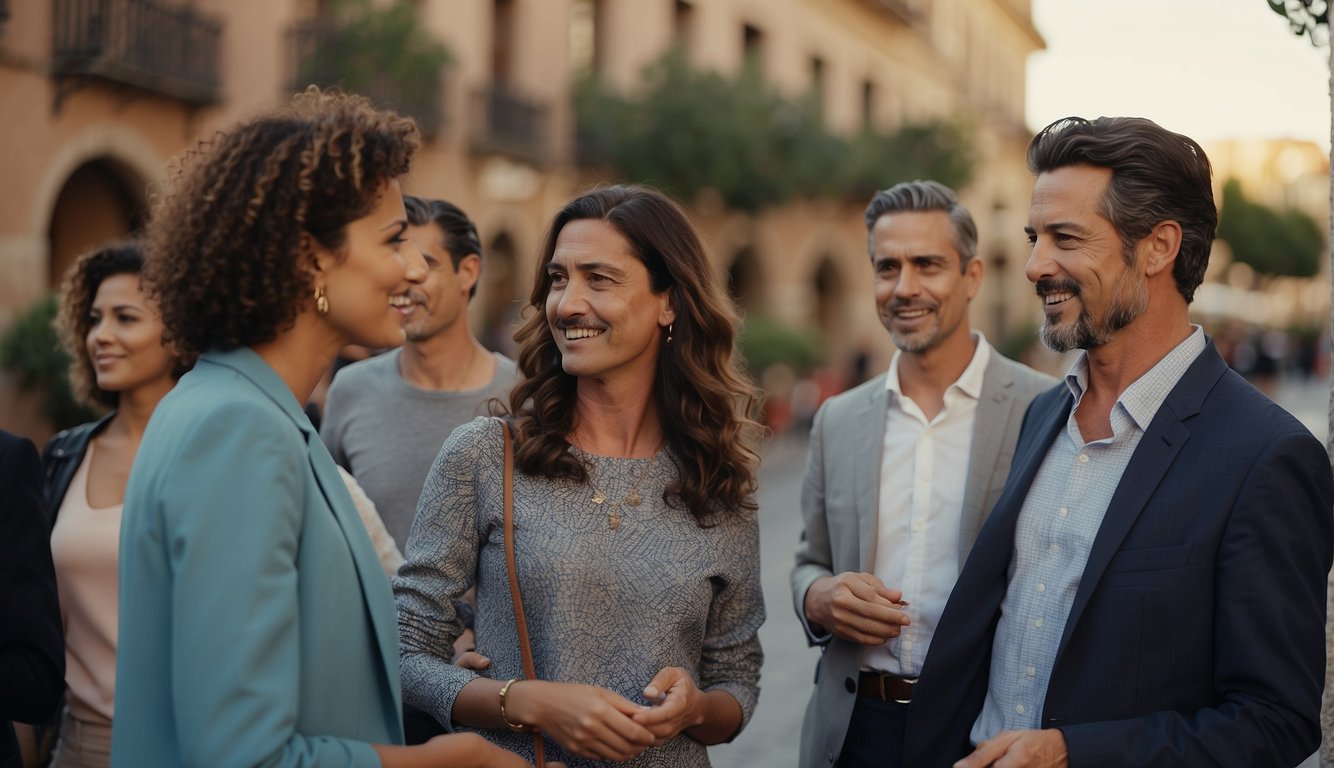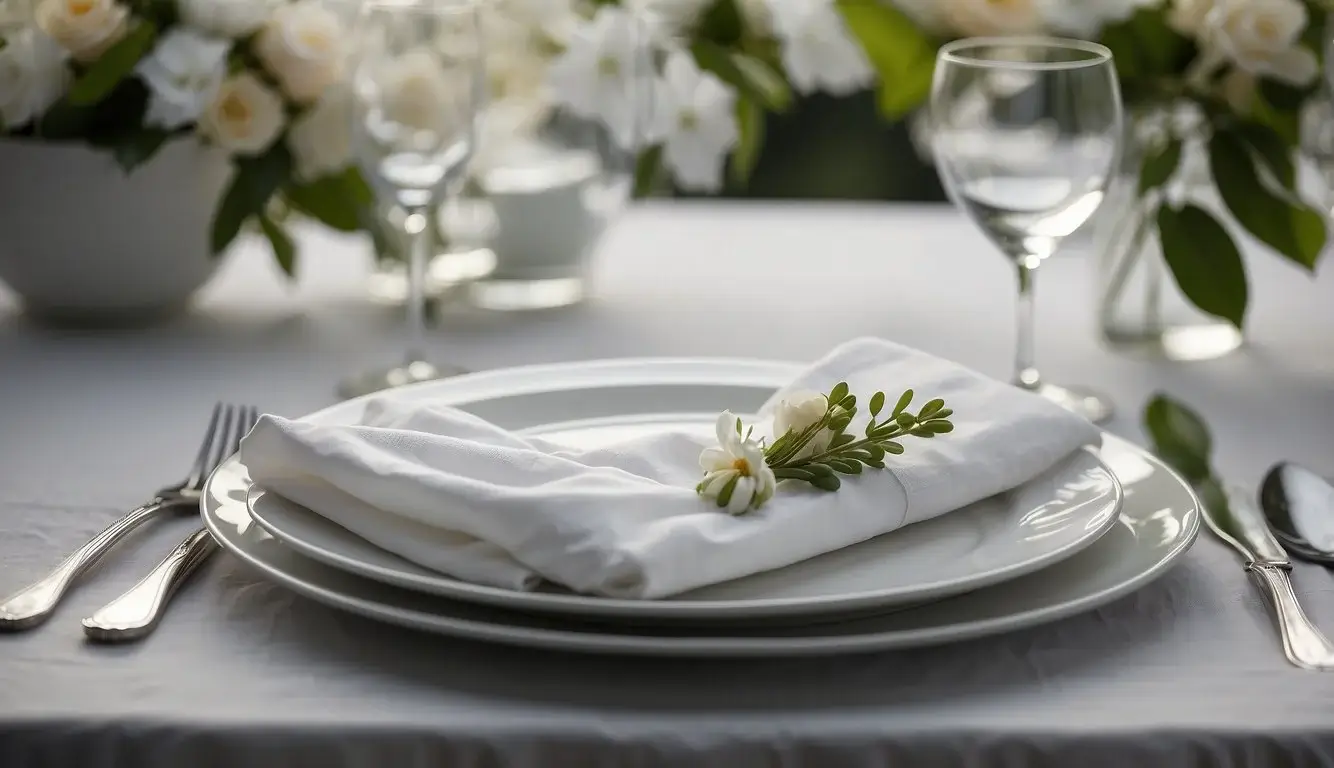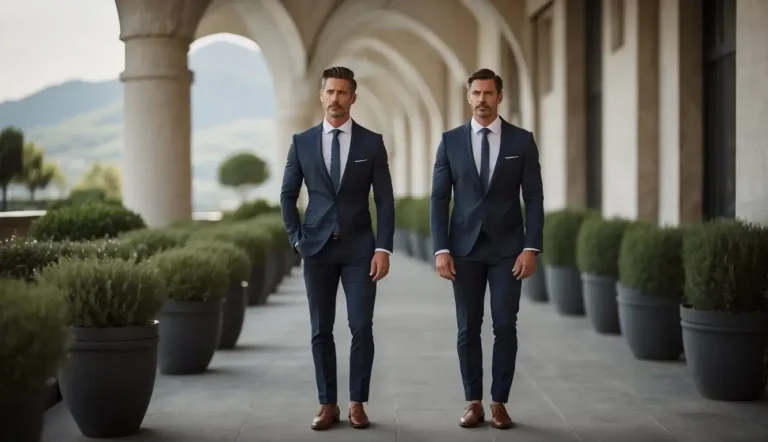I’ve carefully collected and structured the basics of Spanish etiquette, creating a guide that seamlessly integrates you into Spanish-speaking communities. Grasping the nuances of Spanish etiquette is essential for respectful and meaningful interactions, whether you’re offering thanks, greeting someone, or taking part in social events.
This article provides a clear and concise overview, equipping you with the cultural understanding necessary to easily navigate the diverse landscape of Spanish etiquette.
Key Takeaways
- Learning Spanish manners involves understanding the cultural significance behind gestures and expressions.
- Politeness in Spanish-speaking countries encompasses a broad range of social situations and conversational nuances.
- Education in the subtleties of regional etiquette is essential for respectful and effective communication.
Basic Principles of Spanish Politeness

Navigating social interactions in Spanish-speaking cultures means understanding a set of essential phrases and terms that are key to showing respect and maintaining good manners. I’ll guide you through the essentials of addressing people properly, using polite expressions, and greeting or bidding farewell in ways that reflect well on you and honor the culture.
Understanding ‘Tú’ and ‘Usted’
Choosing between ‘tú’ and ‘usted’ is fundamental to Spanish politeness. I use ‘tú’ for people of my age or younger, friends, or family—it’s informal and shows closeness. On the other hand, ‘usted’ is a sign of respect toward someone older, in a position of authority, or when a conversation requires a more formal tone. It’s important to err on the side of caution and use ‘usted’ unless invited to do otherwise.
The Importance of ‘Por Favor’ and ‘Gracias’
For me, it’s second nature to say ‘por favor’ (please) whenever I ask for something. It’s a simple habit that goes a long way in showing courtesy. Similarly, I never forget to express my gratitude with ‘gracias’ (thank you). These expressions should be woven into every Spanish conversation to reflect good manners and politeness, and they’re universally appreciated across all Spanish-speaking cultures.
Polite Greetings and Farewells
Greeting someone with ‘Buenos días’ (good morning), ‘Buenas tardes’ (good afternoon), or ‘Buenas noches’ (good evening) shows a basic level of politeness expected in Spanish culture. Before eating, I say ‘buen provecho’ to those around me, which is akin to ‘enjoy your meal.’ After a sneeze, a polite ‘salud’ (bless you) is customary. When parting, simple farewells like ‘adiós’ (goodbye) or ‘hasta luego’ (see you later) are typical. These greetings and farewells are the bookends of courteous interaction, framing conversations positively from start to finish.
Common Expressions of Courtesy in Spanish

When interacting with Spanish speakers, it’s important to know some key phrases to maintain politeness. These expressions are not just about words but also about the respect and consideration behind them.
Apologizing and Expressing Regret
In Spanish culture, apologizing is vital to convey respect and take responsibility. If you bump into someone or make a mistake, you can say “Perdón” or “Disculpe” to mean “Excuse me.” To express more heartfelt regret, “Lo siento” can be used which means “I’m sorry.” For a more informal apology or when you seek someone’s forgiveness, you might use “Discúlpame.”
Making Requests Politely
To ask for something politely or to make a request, it’s common to use phrases like “Por favor,” which translates to “please.” If you need to get by someone, saying “Permiso” or “Con permiso” shows respect and is more polite than saying anything. When you want to know how someone is doing, you can use expressions like “¿Cómo le va?“, “¿Qué tal?“, or “¿Qué pasa?” which are ways of asking someone how they’re doing.
Responding to Thanks and Good Wishes
When someone thanks you, it’s customary to respond with “De nada,” meaning “You’re welcome.” If someone wishes you good health after you sneeze, you can reply with “¡Salud!” showing appreciation. When someone says “Nice to meet you” or “Mucho gusto,” a polite and friendly response would be “Encantado” if you’re a man or “Encantada” if you’re a woman, which means “pleased to meet you.” To show mutual feelings when someone wishes you something positive, “Igualmente” is a great way to say “Likewise.”
Spanish Etiquette in Social Situations
When I navigate social settings in Spain, I always pay close attention to manners. Specific etiquettes are tied to dining, respect for elders, and meeting new people, all of which reflect the rich Spanish culture.

Dining and Table Manners
In Spain, dining is more than just a meal; it’s a communal event that revolves around shared experience and respect. When I’m at the table, I remember never to begin eating until the host says, “Buen provecho!” Good table manners suggest I should keep my elbows off the table and place my hands where they can be seen. When the meal is over, it’s customary for me to thank the host with a simple, “Gracias por la comida,” showing my appreciation for the dining experience.
Interactions with Elders and Authority Figures
Showing respect to those older than me or in positions of authority is a cornerstone of Spanish culture. I use formal titles such as “Don” or “Doña” followed by their first name when addressing elders. It encapsulates recognition of their stature. For example, if I meet an elder named Maria, I’d respectfully call her “Doña Maria.” It’s a sign of my encouragement and respect towards them, which is deeply valued.
Meeting New People and Saying Goodbye
When meeting someone new, it’s polite to offer a firm handshake while saying, “Encantado” if I’m a man or “Encantada” if I’m a woman, which means “pleased to meet you.” When I leave a gathering, saying “Buenos días,” “Buenas tardes,” or “Buenas noches,” according to the time of day, ensures I part on a friendly note. It’s these small touches of etiquette that demonstrate my respect for Spanish protocol and culture.
Gender and Politeness in Spanish Culture

In my experience with Spanish culture, adherence to polite forms of address, mainly using gender-specific titles, is deeply rooted in tradition and etiquette. Now, let’s explore how gender influences manners and interactions within this rich cultural context.
Gender-Specific Titles and Addressing
When it comes to gender and politeness in Spanish culture, I find it’s essential to understand the correct usage of titles. For women, the titles “Señora” (Mrs.) for married or older women, and “Señorita” (Miss) for younger or unmarried women, carry significant weight in showing respect. For men, the title “Señor” (Mr.) is universally applied regardless of marital status.
Using these titles appropriately showcases respect and upholds traditional manners. Directly addressing someone by their first name without including a title can sometimes be perceived as too familiar or disrespectful, especially in formal or professional settings.
When I speak Spanish, I’m always careful to observe these customs to ensure that my interactions are polite and culturally sensitive. It’s not just about language; it reflects the value placed on respect and courtesy in Spanish communities.
Learning and Practicing Spanish Manners

When I engage in learning Spanish manners, I focus on both the vocabulary and the cultural nuances behind them. It’s about more than just words; it’s about understanding and respecting Spanish customs.
Role of Education in Manners
Education is fundamental in learning Spanish manners. I’ve noticed that studying Spanish opens doors to understanding complex social customs. For example, I learned that using “usted” is a sign of respect, often reserved for elders or in formal settings. To ensure I remember this, I’ve created a table to compare informal and formal address in Spanish:
| Informal (Tú) | Formal (Usted) |
|---|---|
| ¿Cómo estás? | ¿Cómo está usted? |
| ¡Hola! | Buenos días/tardes/noches |
By integrating this knowledge into language lessons, I benefit from clear scenarios that display polite behavior in a Spanish cultural context. This includes practices like greeting with “Buenos días” in the morning or the affectionate “Buenas tardes/noches” depending on the time of day.
Challenges and Tips for Non-Natives
For a non-native like me, grasping the nuances of Spanish manners can be challenging. Accent and pronunciation aside, it’s the subtleties of when and how to use certain expressions that present the biggest learning curve.
Here are some tips I’ve discovered to be useful:
- Listen and Repeat: Immersing myself in native dialogue through media has helped me catch the rhythm and flow of polite Spanish conversation.
- Practice Makes Perfect: Engaging in conversation with Spanish speakers allows me to practice what I’ve learned in real-life scenarios. Even simple exchanges at the local Spanish market can be beneficial.
- Learn Cultural Context: Taking time to understand the culture behind the language has proven essential. Knowing when to kiss cheeks at a greeting or offer a firm handshake avoids awkwardness.
- Expand Vocabulary: I make it a point to regularly update my vocabulary with polite Spanish words and expressions like “por favor” (please), “gracias” (thank, you), and “disculpe” (excuse me).
This direct approach to practice ensures I’m not just learning Spanish but also living it, which ultimately enriches my communication with the essence of Spanish politeness and respect.
Conversational Manners in Spanish

When interacting in Spanish, it’s essential for me to use formal greetings and appropriate conversation starters, especially with people I’m meeting for the first time or in a polite company.
Appropriate Conversation Starters
In Spanish-speaking cultures, it’s common to begin a conversation with polite greetings such as “¿Cómo está usted?” (How are you?) when speaking formally, or “¿Cómo estás?” when the situation is more casual yet still polite. I would use “¿Cómo está?” professionally or formally. Words like “Encantado” (Pleased to meet you), if I am a man, or “Encantada”, if I am a woman, are also essential to convey politeness upon meeting someone. Using phrases like “Quisiera” (I would like) when making requests is also considerate, as it shows respect for the other person’s willingness to help.
- Formal greeting: “Buenos días, ¿cómo está usted?”
- Casual polite greeting: “Hola, ¿cómo estás?”
- To express pleasure in meeting someone: “Encantado/a de conocerle”
Topics to Avoid in Polite Company
It’s just as important to know which topics to avoid so as not to seem impolite or rude. In a formal context, or even in polite company, topics such as religion, politics, or personal financial issues are generally considered inappropriate to bring up, especially when I’m not well-acquainted with the other person. Spanish culture values respect and discretion, so it is safe to avoid controversial or potentially offensive topics in conversation. Additionally, I would avoid using slang terms or expressions that may seem weird or awkward in formal dialogues.
- Avoid: Controversial topics like politics or religion
- Avoid: Slang or informal language that can seem rude or too casual
Cultural Variations of Manners in Spanish-Speaking Countries

Exploring manners across the Spanish-speaking world shows me a fascinating tapestry of cultural norms that guide behaviors. The key to navigating these differences lies in understanding the nuances of local etiquette.
Spain Versus Latin America Differences
In my experience, Spain often emphasizes formality in its use of language, particularly when addressing others. For example, the formal “ustedes” is preferred in certain contexts over the more familiar “vosotros,” which I found is common in many regions of Spain, but not typically used in Latin America.
Spain:
- Formal settings: “ustedes”
- Casual settings: “vosotros” (primarily Castilian Spanish)
Latin America:
- General use: “ustedes”
- Informal or regional variations: “vos” (used in countries like Argentina and Uruguay)
In addition to language differences, I’ve observed variations in social customs. In Spain, it’s polite to say “adelante” to invite someone to enter a home or start eating, whereas in Latin America, this can be seen as overly formal and less common in everyday situations.
Regional Expressions and Habits
Exploring Spanish-speaking countries, I’ve discovered an array of regional expressions and habits that reflect the diversity within these cultures. These regional quirks can often provide deeper insight into the local way of life.
Spain:
- Greeting: Common to give two kisses on the cheek.
- Dining: Sharing plates, or “tapas,” is a social, culinary tradition.
Latin America:
- Greetings can vary widely; in Argentina, a single kiss on the cheek is standard, while a handshake might be more common in other areas.
- Social gatherings often involve close proximity and animated conversation.
Etiquette: I found that understanding regional etiquette is crucial. For instance, in some cultures, punctuality might not be as strictly observed, and being “fashionably late” is considered normal.
These nuances in manners across different Spanish-speaking regions highlight the rich tapestry of cultural practices. I’ve become more adept at respecting and engaging with each unique locale by paying attention to these details.
Special Occasions and Celebratory Phrases

Certain phrases and customs are key to expressing joy and well-wishes on special occasions in Spanish-speaking cultures. I’ll share some specific phrases and customs to ensure you’re ready to join in the celebrations.
Toasting and Celebration Customs
Toasting is a heartfelt part of any celebration in Spain and Latin America. When glasses are raised, it’s common to hear the word “Salud!” which means health. This is a way of wishing good health to everyone present. The ritual often involves looking each person in the eye while clinking glasses as a sign of sincerity and connection.
- Common Toasting Phrases:
- ¡Salud!
- ¡Por tu salud!
- ¡Por nosotros!
For toasts, hold the eye contact, it’s believed to bring honesty to your words and luck to the gathering.
Birthday and Anniversary Wishes
Birthdays and anniversaries are cherished events and expressing your best wishes is essential. “Feliz cumpleaños!” is the equivalent of “Happy Birthday!” and is widely used. Depending on the context, anniversaries can be celebrated with phrases filled with happiness and good wishes.
- Birthday Phrases:
- Feliz cumpleaños, que todos tus deseos se hagan realidad.
- ¡Que cumplas muchos más!
- Anniversary Phrases:
- Felicidades en tu aniversario.
- Que este día especial sea lleno de alegría.
In both scenarios, it’s not uncommon to add personal touches to your wishes or to pair them with blessings. A warm hug, a wide smile, and perhaps a small gift can show how much you care.
Remember, these occasions are about making people feel special, so I advise speaking from the heart and embracing the joy of the moment.
Secondary Conversational Tools in Spanish

In Spanish, verbal communication is just one facet of conversation. My effective conversations also rely on non-verbal cues, which can carry just as much weight as the words I choose.
Using Body Language and Gestures
When I speak Spanish, I’ve noticed that body language is a powerful tool for communicating feelings and meanings beyond words. A friendly smile when greeting someone communicates warmth and openness, while expressive hand gestures can add emphasis and clarity to my point.
For instance, a thumbs-up often means everything is good or approved. However, using culturally appropriate gestures is crucial, as some gestures may have different meanings in different contexts. Learning which body language is polite and acceptable in Spanish-speaking cultures makes a significant difference.
The Role of Eye Contact and Personal Space
Eye contact is another aspect I pay attention to when conversing in Spanish. Maintaining appropriate eye contact signifies my interest and sincerity. However, the amount of eye contact varies from culture to culture, so I balance it to avoid discomfort—similarly, personal space matters; I respect people’s personal bubbles.
Standing too close can be seen as intrusive, but too far might appear unengaged. I’ve realized that in many Spanish-speaking cultures, being at an arm’s length from someone when having a conversation is considered polite and a norm in their conversational style.
a conversation is considered polite and a norm in their conversational style.
FAQ – Manners in Spanish
How do I greet someone politely in Spanish?
- Formal: Use “Buenos días” (Good morning), “Buenas tardes” (Good afternoon), or “Buenas noches” (Good evening/night) combined with “Señor” (Mr.), “Señora” (Mrs.), or “Señorita” (Miss) for a formal greeting.
- Informal: “Hola” (Hello) is universally understood, and “¿Cómo estás?” (How are you?) is commonly used among friends.
What are the common practices for addressing people in Spanish-speaking cultures?
Using titles (e.g., Doctor, Profesor) followed by the surname shows respect in formal contexts. In informal settings, first names are commonly used, but it’s best to wait until invited to do so.
Is physical contact common when greeting in Spanish-speaking countries?
Yes, physical contact is more common and varies by country. A handshake is standard in formal situations, while a single cheek kiss (right cheek to right cheek) is typical among friends or acquaintances in many Spanish-speaking countries. In some regions, men may embrace or pat each other on the shoulder.
If you enjoyed reading about Manners in Spanish, check out our other articles:
- Bowling Etiquette 2024: Tips for Polite Play on the Lanes
- Surf Etiquette 2024: Key Rules for Sharing the Waves
- Tennis Etiquette 2024: Key Rules and Polite Play for Beginners
- Laundromat Etiquette 2024: Tips for a Harmonious Wash Day
Feel free to also check out our other Articles from the category “Etiquette & Manners“ and don’t forget to follow us on Pinterest






